Abstract
We demonstrate herein that the well documented hyperresponsiveness to erythropoietin (Epo) of Ba/F3 cells expressing C-terminal truncated erythropoietin receptors (EpoRs) is contingent on these cells being in fetal calf serum (FCS). In the absence of FCS, their Epo-induced proliferation is far poorer than Ba/F3 cells expressing wild-type (WT) EpoRs. This hyporesponsiveness in the absence of serum is also seen in DA-3 cells expressing these truncated EpoRs. In fact, long-term proliferation studies performed in the absence of serum show that even at saturating concentrations of Epo, Ba/F3 cells expressing these truncated receptors die via apoptosis, while cells bearing WT EpoRs do not, and this programmed cell death correlates with an inability of Epo-stimulated Ba/F3 cells expressing truncated EpoRs to induce the tyrosine phosphorylation of MAPK and the activation of p70S6K. Using neutralizing antibodies to insulin-like growth factor (IGF)-1, we show that a major non-Epo factor in FCS that contributes to the hyperresponsive phenotype of Ba/F3 cells expressing truncated EpoRs is IGF-1. Our results suggest that the Epo-hypersensitivity of truncated EpoR expressing Ba/F3 cells is due to the combined effects of these EpoRs not possessing a binding site for the negative regulator, SHP-1, and the triggering of proliferation-inducing/apoptosis-inhibiting cascades, lost through EpoR truncation, by IGF-1.
ERYTHROPOIETIN (Epo), a potent stimulator of mammalian erythropoiesis,1 exerts its effects by binding to a transmembrane receptor, which is present on the surface of relatively mature erythroid progenitors.2,3 This Epo receptor (EpoR) belongs to the hematopoietin receptor superfamily and thus does not possess a protein tyrosine kinase domain within its cytoplasmic tail.4,5 Nonetheless, it6-9, along with a number of other intracellular proteins (including phospholipase Cγ-110; the SH2-containing inositol phosphatase, SHIP11-14; the Janus kinase, Jak215; the Ras GTPase activating protein, RasGAP16; the signal transducer and activator of transcription, Stat517-20; the two tyrosine phosphatases, SHP-1 (aka HCP, PTP1C)21,22; and SHP-2 (aka Syp, PTP1D)23,24; and the p52 and p46 isoforms of the adaptor protein Shc11, becomes transiently phosphorylated on tyrosine residues within minutes of binding its ligand. These tyrosine phosphorylations appear to be performed, at least in part, by Jak2.15,25-27 Following the tyrosine phosphorylation of the EpoR, a number of Src homology 2 (SH2)-containing proteins become associated with it (the EpoR does not possess any NXXpY binding motifs for phosphotyrosine binding (PTB) domains5,28). These include Stat5, which binds with highest affinity to the membrane proximal pY343 17,29 (based on the nomenclature for the mature protein); SHP-2, which binds to pY401 24; SHP-1, which binds to pY429 22; Shc, which binds to more than one pY30 (and unpublished data); Grb2, which binds to pY464 30 and phosphatidylinositol 3-kinase (PI 3-K), which binds to the C-terminal pY479.31Given that these SH2-containing proteins, except for the tyrosine phosphatase SHP-1, have been shown to promote proliferation in Epo-stimulated cells, as well as in other growth factor systems,17,24,29,32 we found it intriguing that EpoR deletion mutants containing only the membrane proximal Y343, appeared to function better than wild-type (WT) EpoRs in mediating Epo-induced proliferation, at least in certain hematopoietic cell lines (eg, Ba/F333, 32D34). This hypersensitivity has been attributed to the absence of a binding site on the EpoR for SHP-1,22 as binding of SHP-1 to the EpoR has been shown to play a negative role in Epo-induced proliferation by dephosphorylating Jak2 and perhaps the EpoR itself.21,22 35 If this is indeed the case, it suggests that the negative effects of SHP-1 greatly outweigh the combined proliferation-inducing effects of Shc, Grb2, SHP-2, and PI 3-K. To examine this further, we compared the ability of Ba/F3 and DA-3 cells expressing the same number of cell surface WT and truncated EpoRs to proliferate in response to Epo under both serum-free and fetal calf serum (FCS)-containing conditions. Our results demonstrate that when either Ba/F3 or DA-3 cells expressing C-terminal truncated EpoRs are stimulated with saturating levels of Epo in the absence of FCS, they proliferate far less well than their WT counterparts in short-term proliferation studies. Moreover, we show that truncated, but not WT, EpoR expressing Ba/F3 cells apoptose in serum-free long-term cultures containing saturating levels of Epo and that this programmed cell death correlates with an inability of Epo-stimulated Ba/F3 cells expressing truncated EpoRs to induce the tyrosine phosphorylation of MAPK and the activation of p70S6K. In addition, we show that insulin-like growth factor (IGF)-1 is one of the principal factors in FCS responsible for the hyperresponsiveness of Ba/F3 cells expressing these truncated EpoRs.
MATERIALS AND METHODS
Cells and proliferation assays.
The murine interleukin-3 (IL-3)–dependent cell lines, Ba/F3, kindly supplied by Dr A. Miyajima (DNAX Research Institute, Palo Alto, CA), and DA-3, generously provided by Dr J. Ihle (St Judes Children's Hospital, Memphis, TN) were retrovirally infected with a JZenTKneo vector containing either the WT or C-terminal 91 amino acid truncated (d392) murine EpoR cDNA, as described previously.6,17Clones expressing similar levels of cell surface EpoRs, based on fluorescence-activated cell sorting (FACS) analysis with biotinylated Epo3 and on binding studies with125I-Epo,33 were selected and grown in RPMI containing 10% FCS, 1.8 mg/mL G418 and 5 ng/mL COS cell-derived murine IL-3. For short-term proliferation assays, Ba/F3 and DA-3 cells expressing the same number of cell surface WT and d392 EpoRs (termed Ba/F3-WT, Ba/F3-d392, and DA-3-WT, DA-3-d392, respectively) were grown to near confluence with IL-3, washed once with RPMI 1640, and resuspended in RPMI 1640 containing either 10% heat inactivated FCS (ie, 56°C for 30 minutes) or a synthetic serum mixture (SS) composed of 2% bovine serum albumin (BSA) (StemCell Technologies Inc, Vancouver, British Columbia, Canada; catalogue no. HCC-9300), 200 μg/mL iron-saturated transferrin (ICN ImmunoBiological, Costa Mesa, CA; catalogue no. 82-343), 40 μg/mL low density lipoproteins (Sigma Chemical Co, St Louis, MO; catalogue no. L-2139), 5 × 10−5 mol/L 2-mercaptoethanol and penicillin/streptomycin at 102 U and 50 μg/mL, respectively. The cells, at 2.5 × 104 cells/well, were then aliquoted into 96-well U-bottom microtitre plates (Linbro; ICN, Mississauga, Ontario, Canada) to give a final volume of 100 μL/well and the plates incubated for 22 hours at 37°C in a humidified atmosphere of 5% CO2, 95% air. A total of 20 μL of a 50-μCi/mL solution of 3H-thymidine (3H-Tdr) in RPMI was then added to each well to give a final concentration of 1 μCi/well. After another 2 hours at 37°C, the contents of each well were harvested onto filtermats and counted using an LKB Betaplate Harvester and Liquid Scintillation Counter (LKB Wallac, Turku, Finland). In short-term experiments in which neutralizing antihuman IGF-1 antibodies (R & D Systems, Minneapolis, MN; catalogue no. AF-291-NA) were used to preclear IGF-1 (R & D Systems; catalogue no. 291-G1) or FCS, 100 μL of 2 nmol/L IGF-1 or 100 μL of a 10% FCS solution in RPMI were incubated at 4°C overnight with 100 μL of a 125 μg/mL solution of goat antihuman IGF-1 antibody or 100 μL of a 125 μg/mL solution of a control goat antirabbit IgG (Jackson Laboratories, Bar Harbor, ME). Protein A-agarose beads (Pierce, Rockford, IL; catalogue no. 20333, 20 mg) were then added and the suspension gently rocked for 90 minutes at 23°C. The suspensions were then subjected to centrifugation for 10 minutes at 8,000g and the supernatants tested in the assay in place of FCS. For long-term proliferation assays, Ba/F3-WT and Ba/F3-d392 cells, growing exponentially in 10 ng/mL recombinant murine IL-3 and 10% FCS, were washed twice in RPMI 1640 and resuspended in this medium plus 5 U/mL Epo with either 10% FCS or SS at 2 × 105 cells/mL on day 0. The cells were subcultured so that they remained between 2 × 105 and 1 × 106 cells/mL and viable cell counts (trypan blue exclusion) performed daily.
Apoptosis assays.
For DNA laddering studies, 2 × 106 Ba/F3-WT and Ba/F3-d392 cells were harvested after 1 day growth with 5 U/mL Epo in SS, using our long-term proliferation assay conditions, lysed in 50 μL of 50 mmol/L Tris-HCl, pH 7.5, 20 mmol/L EDTA containing 0.5% NP-40, and protein and RNA removed by digestion with RNase A (5 μg/μL) and proteinase K (2.5 μg/μL), respectively. The ethanol precipitated DNA was then dissolved in gel loading buffer and electrophoresed using 2% agarose gels containing 0.1 μg/mL EtBr.36
Northern blot analysis.
Exponentially growing Ba/F3-WT and Ba/F3-d392 cells were starved for 4 hours in RPMI 1640 plus 0.1% BSA and then stimulated for 90 minutes with 5 U/mL Epo. The cells were lysed in Trizol (Life Technologies, Burlington, Ontario, Canada) and the total cellular RNA was isolated as recommended by the manufacturer. Northern blot analysis was performed as described previously37 and the probes used for hybridization were a full-length mouse bcl-x (long) cDNA (generously provided by Dr C.B. Thompson, Howard Hughes Medical Institute, Chicago, IL), a full-length murine bcl-2 cDNA (kindly provided by Dr R. Kay, Terry Fox Laboratory, Vancouver, British Columbia, Canada) and, to test for loading equivalence, a 1.3-kb pair PstI fragment of rat glyceraldehyde-3-phosphate dehydrogenase (GAPDH) cDNA (provided by Dr P. Jeanteur, Centre Paul Lamarque, Monpellier, France).
Immunoprecipitations and Western blotting.
Ba/F3-WT and Ba/F3-d392 cells were starved in RPMI plus 0.1% BSA for 4 hours at 37°C and then treated with or without 50 U/mL Epo in SS or 50% FCS at 37°C for 30 minutes. The cells were then lysed at 2 × 107 cells/mL in hypotonic lysis buffer,17 boiled in 1% sodium dodecyl sulfate (SDS) and diluted 10-fold with 4°C phosphorylation solubilization buffer (PSB; ie, 50 mmol/L HEPES, pH 7.4, 100 mmol/L NaF, 10 mmol/L NaPPi, 2 mmol/L Na3VO4, 4 mmol/L EDTA, 2 mmol/L phenylmethyl sulfonyl fluoride (PMSF), 10 μg/mL leupeptin, and 2 μg/mL aprotinin) containing 1% NP-40 before immunoprecipitating with anti-MAPK antibodies (UBI, ERK1-CT, Cat # 06-182). MAPK was eluted by boiling in SDS-sample buffer and subjected to 12.5% polyacrylamide SDS-polyacrylamide gel electrophoresis (PAGE) and Western analysis with antiphosphotyrosine antibodies (4G10; Upstate Biotechnology, Lake Placid, NY) as previously described.17
p70S6K assays.
Exponentially growing Ba/F3-WT and Ba/F3-d392 cells were starved for 4 hours in RPMI 1640 plus 0.1% BSA and then stimulated for the times indicated with 5 U/mL Epo in SS. The cells were then lysed at 2 × 107 cells/mL with 4°C PSB containing 1% NP-40, and the lysates made 0.5 mol/L with NaCl, precleared with Protein A Sepharose, and immunoprecipitated with 0.5 μg anti-p70S6K-CT antibodies (Santa Cruz) and Protein A Sepharose. The beads were washed sequentially with 6% NETF (ie, 6% NP-40 in NETF buffer, ie 100 mmol/L NaCl, 5 mmol/L EDTA, 50 mmol/L Tris-Cl, pH 7.4, 50 mmol/L NaF), 3% NETF high salt (ie, 3% NP-40 in 250 mmol/L NaCl NETF), NETF and assay dilution buffer (20 mmol/L MOPS, pH 7.2, 25 mmol/L β-glycerophosphate, 20 mmol/L MgCl2, 5 mmol/L EGTA, 2 mmol/L EDTA, 1 mmol/L dithiothreitol [DTT] 5 μmol/L β-methylaspartic acid, and 1 mmol/L Na3VO4) before an in vitro kinase assay was performed using the substrate peptide S610 (ie, AKRRRLSSLRAGGRR) and [γ-32P]-adenosine triphosphate (ATP) as described previously.38
RESULTS
Truncated EpoRs do not confer hyperresponsiveness to Epo in the absence of FCS.
To compare the Epo-responsiveness of cells expressing full-length versus C-terminal truncated EpoRs retaining only the membrane proximal tyrosine, we retrovirally infected the murine IL-3–dependent hematopoietic cell line, Ba/F3, with WT murine EpoRs and with truncated murine EpoRs lacking the C-terminal 91 amino acids, ie, d392. Clones expressing the same number of cell surface receptors, as determined by binding studies with 125I-Epo,33 were compared for their ability to proliferate in response to Epo, using standard short-term proliferation assays containing 10% FCS. As can be seen in Fig 1A, the d392 EpoR expressing cells (Ba/F3-d392 cells) were hyperresponsive to Epo, requiring approximately 10-fold less Epo to proliferate, as well as their WT expressing (Ba/F3-WT) counterparts. However, at high concentrations of Epo (5 U/mL) the proliferation rate was the same. These findings are consistent with previous reports.33 To determine if this hyperresponsiveness was due solely to the action of Epo, these proliferation assays were repeated with these same two clones in the presence of SS (see Materials and Methods) instead of FCS (Fig 1B). Now, the Ba/F3-d392 cells proliferated far less well than their WT counterparts, even at saturating concentrations of Epo. Very similar results were obtained with three independently isolated WT and d392-expressing Ba/F3 cell clones, matched for EpoR cell surface expression. We also examined the Epo responsiveness of these two EpoRs in the murine hematopoietic cell line, DA-3, which has been shown previously not to be hyperresponsive when expressing a C-terminally truncated EpoR.8 As can be seen in Fig 1C, when WT and d392 DA-3 cells expressing the same number of cell surface EpoRs were compared in short-term proliferation assays in the presence of FCS, the two cell types responded similarly to low Epo concentrations, but the WT cells were slightly more responsive at higher Epo concentrations, in keeping with earlier findings from both our laboratory17and others.8 However, in SS the difference in the Epo-induced proliferation of the two cell types was much more pronounced, with the d392 DA-3 cells incorporating far less3H-thymidine than WT cells (Fig 1D).
d392 EpoR expressing Ba/F3 cells are not hyperresponsive to Epo when Epo is the only mitogen present. (A) Epo-dose response curves were generated using short-term proliferation assays, with Ba/F3-WT (▪) and Ba/F3-d392 (▴) cells in 10% FCS. (B) Epo-dose response curves were generated using short-term proliferation assays, with the same Ba/F3-WT (▪) and Ba/F3-d392 (▴) cells in SS. (C) Epo-dose response curves were generated using short-term proliferation assays, with DA-3-WT (▪) and DA-3-d392 (▴) cells in 10% FCS. (D) Epo-dose response curves were generated using short-term proliferation assays, with the same DA-3-WT (▪) and DA-3-d392 (▴) cells in SS.
d392 EpoR expressing Ba/F3 cells are not hyperresponsive to Epo when Epo is the only mitogen present. (A) Epo-dose response curves were generated using short-term proliferation assays, with Ba/F3-WT (▪) and Ba/F3-d392 (▴) cells in 10% FCS. (B) Epo-dose response curves were generated using short-term proliferation assays, with the same Ba/F3-WT (▪) and Ba/F3-d392 (▴) cells in SS. (C) Epo-dose response curves were generated using short-term proliferation assays, with DA-3-WT (▪) and DA-3-d392 (▴) cells in 10% FCS. (D) Epo-dose response curves were generated using short-term proliferation assays, with the same DA-3-WT (▪) and DA-3-d392 (▴) cells in SS.
Even more dramatic differences were observed in long-term proliferation assays. In these assays Ba/F3-WT and Ba/F3-d392 cells were grown in the presence of 5 U/mL Epo and, as expected from the results obtained in Fig 1A, they proliferated at the same rate in the presence of FCS (Fig 2A). However, in SS, Ba/F3-d392 cells died, even though saturating concentrations of Epo were present (Fig2A). Ba/F3-WT cells, on the other hand, proliferated under these conditions, although not as rapidly as in FCS, indicating that non-Epo factors in FCS contribute to the proliferation of Ba/F3-WT cells as well (Fig 2A). These results demonstrate that the C-terminus of the EpoR is required for both proliferation and survival when Epo is the only mitogen present.
d392 EpoR expressing Ba/F3 cells die via apoptosis when Epo is the only mitogen present. (A) Long-term proliferation assays were performed with Ba/F3-WT cells in 5 U/mL Epo plus 10% FCS (▪), and in 5 U/mL plus SS (□) and with Ba/F3-d392 cells in 5 U/mL Epo plus 10% FCS (▴) and 5 U/mL plus SS (▵). Data points for A, B, and C represent the mean ± standard error (SE) of triplicate determinations. (B) Agarose gel electrophoresis of DNA taken 24 hours after culture from Ba/F3-WT cells grown in FCS (1) and SS (2) and from Ba/F3-d392 cells grown in FCS (3) and SS (4). All cultures contained 5 U/mL Epo.
d392 EpoR expressing Ba/F3 cells die via apoptosis when Epo is the only mitogen present. (A) Long-term proliferation assays were performed with Ba/F3-WT cells in 5 U/mL Epo plus 10% FCS (▪), and in 5 U/mL plus SS (□) and with Ba/F3-d392 cells in 5 U/mL Epo plus 10% FCS (▴) and 5 U/mL plus SS (▵). Data points for A, B, and C represent the mean ± standard error (SE) of triplicate determinations. (B) Agarose gel electrophoresis of DNA taken 24 hours after culture from Ba/F3-WT cells grown in FCS (1) and SS (2) and from Ba/F3-d392 cells grown in FCS (3) and SS (4). All cultures contained 5 U/mL Epo.
Incubation of Ba/F3-d392, but not -WT cells, with Epo in the absence of FCS leads to apoptosis and this correlates with an inability of Epo to induce MAPK tyrosine phosphorylation or p70S6Kactivation in these cells.
To determine if the Ba/F3-d392 cells in SS-containing long-term cultures were dying via programmed cell death, aliquots of Ba/F3-WT and Ba/F3-d392 cells, growing in the presence of 5 U/mL of Epo and either 10% FCS or SS, were taken after 24 hours of culture, lysed as described in Materials and Methods, and the DNA subjected to electrophoresis in agarose gels.36 Even though at this time point there was no difference evident in viable cell numbers among the four cultures (see Fig 2A), the presence of DNA laddering was clearly evident in the Ba/F3-d392 cells, but not in the Ba/F3-WT cells, grown in SS (Fig 2B). As expected, neither Ba/F3-d392 nor Ba/F3-WT cells grown in FCS displayed any signs of apoptosis (Fig 2B). Thus, even in the presence of saturating concentrations of Epo, Ba/F3-d392 cells die via programmed cell death in the absence of FCS.
To gain some insight into the possible mechanism(s) involved in this apoptosis, we first examined the Epo-induced tyrosine phosphorylation of the MAP kinases p44ERK1 and p42ERK2 (which correlates with their activation state39) in both Ba/F3-WT and Ba/F3-d392 cells in response to Epo (Fig 3A). In the absence of FCS, Epo stimulated the tyrosine phosphorylation of p42ERK2 in WT, but not in d392 cells, in keeping with previous reports.39Interestingly, FCS alone was also capable of stimulating the tyrosine phosphorylation of p42ERK2 in both WT and d392 cells and when Epo and FCS were added together, there was a marked synergy in the phosphorylation level of this MAPK in both cell types, although the level in d392 cells was substantially lower. Reprobing this blot with anti-MAPK antibodies demonstrated equal loading of the lanes (Fig 3A, lower panel).
Epo-induced Ba/F3-d392 cells, like BA/F3-WT cells, increase Bcl-XL mRNA levels, but do not induce MAPK tyrosine phosphorylation or p70S6K activation. (A) Ba/F3-WT and -d392 cells stimulated with or without 50 U/mL of Epo for 30 minutes in the presence of SS or 50% FCS were lysed and subjected to immunoprecipitation with anti-MAPK antibodies and Western analysis with 4G10. The lower panel is a reprobing with anti-MAPK antibodies to show equal loading. (B) Ba/F3-WT and Ba/F3-d392 cells were starved for 4 hours in RPMI 1640 plus 0.1% BSA (lane 1), stimulated for 90 minutes with 5 U/mL Epo (lane 2) or 5 U/mL Epo + 10% FCS (lane 3), and total cellular RNA subjected to Northern blot analysis with bcl-xL, bcl-2 and GAPDH probes as described in Materials and Methods. (C) Ba/F3-WT and Ba/F3-d392 cells were starved for 4 hours in RPMI 1640 plus 0.1% BSA, incubated with 5 U/mL Epo for 0, 30, 60, and 120 minutes and then lysed, immunoprecipitated with anti-p70S6K antibodies, and the immunoprecipitate subjected to an in vitro kinase assay using the substrate peptide S610. The results are representative of two independent experiments.
Epo-induced Ba/F3-d392 cells, like BA/F3-WT cells, increase Bcl-XL mRNA levels, but do not induce MAPK tyrosine phosphorylation or p70S6K activation. (A) Ba/F3-WT and -d392 cells stimulated with or without 50 U/mL of Epo for 30 minutes in the presence of SS or 50% FCS were lysed and subjected to immunoprecipitation with anti-MAPK antibodies and Western analysis with 4G10. The lower panel is a reprobing with anti-MAPK antibodies to show equal loading. (B) Ba/F3-WT and Ba/F3-d392 cells were starved for 4 hours in RPMI 1640 plus 0.1% BSA (lane 1), stimulated for 90 minutes with 5 U/mL Epo (lane 2) or 5 U/mL Epo + 10% FCS (lane 3), and total cellular RNA subjected to Northern blot analysis with bcl-xL, bcl-2 and GAPDH probes as described in Materials and Methods. (C) Ba/F3-WT and Ba/F3-d392 cells were starved for 4 hours in RPMI 1640 plus 0.1% BSA, incubated with 5 U/mL Epo for 0, 30, 60, and 120 minutes and then lysed, immunoprecipitated with anti-p70S6K antibodies, and the immunoprecipitate subjected to an in vitro kinase assay using the substrate peptide S610. The results are representative of two independent experiments.
Leverrier et al37 recently demonstrated that the apoptosis, which results from the withdrawal of IL-3 from Ba/F3 cells, correlates with a drop in Bcl-XL (but not Bcl-2) mRNA and protein levels and that the IL-3–stimulated maintenance of Bcl-XLlevels was dependent on MAPK activity. We therefore incubated Ba/F3-WT and -d392 cells, after growth factor and FCS deprivation, with 5 U/mL Epo and followed Bcl-XL and Bcl-2 mRNA levels. While there was no significant change in Bcl-2 mRNA levels under these conditions (in keeping with the results of Leverrier et al37), Bcl-XL mRNA levels increased significantly and to approximately the same extent in response to Epo in Ba/F3-WT and -d392 cells (Fig 3B). As can also be seen in Fig 3B, stimulating these cells with Epo plus FCS did not increase the level of Bcl-XL over that observed with Epo alone. These results indicated that (1) increased production of Bcl-XL can occur in the absence of detectable MAPK activation and that (2) its increase is not sufficient to prevent apoptosis.
We then turned our attention to the PKB pathway, as it was very recently shown that the protein kinase PKB (aka Akt) is activated by IL-3 and plays an important role in preventing programmed cell death in IL-3–dependent cell lines,40 perhaps by phosphorylating (and thus inactivating) the apoptosis promoter, BAD.41Specifically, we performed a time course study to determine if Epo was capable of stimulating the downstream kinase, p70S6K, in Ba/F3-WT and -d392 cells in the absence of FCS. As can be seen in Fig3C, this enzyme was only stimulated in WT cells. This may indicate that Ba/F3-d392 cells apoptose in the absence of FCS because Epo cannot stimulate the PKB pathway in these cells.
IGF-1 in FCS acts synergistically with Epo to stimulate Ba/F3-WT and Ba/F3-d392 cells.
To gain some insight into the nature of the factor(s) in FCS responsible for converting Ba/F3-d392 cells from an Epo hypo- to an Epo-hyperresponsive phenotype, we first demonstrated that this activity was not restricted to FCS, but was also present in human serum, horse serum, and mouse serum, suggesting it was highly conserved (data not shown). We then dialyzed FCS, using dialysis bags with pore sizes ranging from 1 to 10 kD and found this activity remained in the dialysis bag after these treatments, consistent with the active principle being a macromolecule. To determine if this macromolecule was a known polypeptide, various candidate mitogens were tested, including Steel factor, thrombopoietin, insulin, and IGF-1, for their effects, in the presence and absence of Epo, on the proliferation of Ba/F3-WT and Ba/F3-d392 cells in SS. Steel factor was found to have no effect on these cells, and while thrombopoietin did act synergistically with Epo to stimulate Ba/F3-WT and Ba/F3-d392 cells, it had a more potent effect on the former (data not shown). Both insulin and IGF-1, on the other hand, were capable of mimicking the effects of FCS on Epo-induced Ba/F3-WT and Ba/F3-d392 cell proliferation, ie, they increased the proliferation rate of Ba/F3-d392 cells far more than that of Ba/F3-WT cells (Fig 4A). However, dose response curves showed that the level of insulin required to elicit this effect far exceeded the levels typically present in FCS (Fig 4B). This, however, was not the case with IGF-1, where levels shown to be present in FCS, ie, 70 ng/mL (approximately 10 nmol/L),42 markedly stimulated Ba/F3-WT and especially Ba/F3-d3292 cells, when added together with Epo (Fig 4C). To test whether IGF-1 was indeed the factor in FCS responsible for converting Ba/F3-d392 cells from a hypo- to a hyperresponsive phenotype, FCS was precleared of IGF-1 using anti–IGF-1 antibodies and protein A-Sepharose beads and then tested for its ability to synergize with Epo in stimulating Ba/F3-d392 cell proliferation. As can be seen in Fig 5, anti–IGF-1 antibody, but not a control antibody, markedly reduced this stimulatory activity in FCS. However, this treatment, performed three times with various concentrations of anti–IGF-1, did not totally eliminate the stimulatory effects of FCS, suggesting the presence of other mitogens as well.
Insulin or IGF-1 mimics the proliferative effects of FCS on Ba/F3-WT and Ba/F3-d392 cells. (A) Short-term Epo-dose response assays were performed with Ba/F3-WT (▪,□) and Ba/F3-d392 (▴,▵) cells in SS plus (□,▵) and minus (▪,▴) 10 nmol/L IGF-1. Identical results were obtained with 10 μg/mL insulin. (B) Short-term insulin dose response studies were performed with Ba/F3-WT (▪) and Ba/F3-d392 (▴) cells in SS in the presence of 50 mU/mL Epo. (C ) Short-term IGF-1 dose response studies were performed with Ba/F3-WT (▪) and Ba/F3-d392 (▴) cells in SS in the presence of 50 mU/mL Epo. Data points represent the mean ± SE of triplicate determinations.
Insulin or IGF-1 mimics the proliferative effects of FCS on Ba/F3-WT and Ba/F3-d392 cells. (A) Short-term Epo-dose response assays were performed with Ba/F3-WT (▪,□) and Ba/F3-d392 (▴,▵) cells in SS plus (□,▵) and minus (▪,▴) 10 nmol/L IGF-1. Identical results were obtained with 10 μg/mL insulin. (B) Short-term insulin dose response studies were performed with Ba/F3-WT (▪) and Ba/F3-d392 (▴) cells in SS in the presence of 50 mU/mL Epo. (C ) Short-term IGF-1 dose response studies were performed with Ba/F3-WT (▪) and Ba/F3-d392 (▴) cells in SS in the presence of 50 mU/mL Epo. Data points represent the mean ± SE of triplicate determinations.
IGF-1 is a major mitogen in FCS for Ba/F3-d392 cells. Short-term proliferation assays were performed with Ba/F3-d392 cells stimulated with 100 mU/mL Epo ± 0.2 nmol/L IGF-1, ± 0.2 nmol/L IGF-1 after pretreatment with anti–IGF-1, ± 0.2 nmol/L IGF-1 after pretreatment with control anti-IgG, ± 1% FCS, ± 1% FCS after pretreatment with anti–IGF-1, and ± 1% FCS after pretreatment with control anti-IgG, as described in Materials and Methods. Data points represent the mean ± SE of triplicate determinations.
IGF-1 is a major mitogen in FCS for Ba/F3-d392 cells. Short-term proliferation assays were performed with Ba/F3-d392 cells stimulated with 100 mU/mL Epo ± 0.2 nmol/L IGF-1, ± 0.2 nmol/L IGF-1 after pretreatment with anti–IGF-1, ± 0.2 nmol/L IGF-1 after pretreatment with control anti-IgG, ± 1% FCS, ± 1% FCS after pretreatment with anti–IGF-1, and ± 1% FCS after pretreatment with control anti-IgG, as described in Materials and Methods. Data points represent the mean ± SE of triplicate determinations.
In light of these results, we postulated that DA-3 cells expressing the d392 EpoR might be less Epo-responsive than Ba/F3 cells bearing this same EpoR (in the presence of FCS) because DA-3 cells are less responsive to IGF-1. To investigate this, we first repeated the experiment shown in Fig 4A, this time using DA-3-WT and d392 cells and found that IGF-1 mimicked the results obtained with FCS (ie, we obtained the same nonhyperresponsive phenotype as that seen with FCS in Fig 1C, data not shown). We then simply compared IGF-1–induced proliferation responses of three independently isolated clones of both DA-3 and Ba/F3 cells in short-term 3H-Tdr assays. Although there was some clonal variation, Ba/F3 cells were consistently more responsive than DA-3 cells to IGF-1 (Fig6), suggesting that DA-3 cells expressing truncated EpoRs may not be hyperresponsive to Epo in the presence of FCS because they do not respond to the IGF-1 in FCS.
IGF-1 stimulates the proliferation of Ba/F3, but not DA-3 cells. Short-term IGF-1 dose response studies were performed with three individually isolated Ba/F3 cell clones (parental, ▪; Ba/F3-WT 1, •; Ba/F3 WT 8, ▾) and three individually isolated DA-3 cell clones (DA-3-WT 3, □; DA-3 WT 6, ○; and DA-3-WT 17, ▵) in SS. Data points represent the mean ± SE of triplicate determinations.
IGF-1 stimulates the proliferation of Ba/F3, but not DA-3 cells. Short-term IGF-1 dose response studies were performed with three individually isolated Ba/F3 cell clones (parental, ▪; Ba/F3-WT 1, •; Ba/F3 WT 8, ▾) and three individually isolated DA-3 cell clones (DA-3-WT 3, □; DA-3 WT 6, ○; and DA-3-WT 17, ▵) in SS. Data points represent the mean ± SE of triplicate determinations.
DISCUSSION
Our results indicate, contrary to current thinking, that C-terminally truncated EpoRs are far less capable of triggering Epo-induced proliferation/survival signals than their WT counterparts. In fact, in the absence of FCS, Ba/F3 cells expressing these truncated receptors apoptose even in the presence of supraphysiologic levels of Epo. We suggest that this apoptosis may be due, at least in part, to the inability of Ba/F3-d392 cells to stimulate the PKB and MAPK pathways in response to Epo, and we are currently engaged in exploring this further. Complicating this picture, however, is the likelihood that the pathways regulating proliferation are distinct from those controlling survival. For example, as can be seen in Fig 3A, MAPK tyrosine phosphorylation was substantially higher in WT than in d392 Ba/F3 cells, when stimulated with Epo plus FCS, even though d392 cells under these conditions were at least as responsive in proliferation assays. This could suggest that a minimal MAPK (and PKB) activity is required to prevent apoptosis of Ba/F3 cells and that the major determinant of proliferation rate is the Jak2/Stat5 pathway. In fact, this was suggested by previous work in our laboratory with DA-3 cells,17 and it was recently shown that 32D cells expressing a similar truncated EpoR to that used in the current study retain Stat5 activity two to three times longer in response to Epo than WT EpoR-expressing cells.34 Thus Ba/F3-d392 cells growing in FCS with suboptimal levels of Epo may grow at a faster rate than Ba/F3-WT cells because the former proliferate faster due to a decreased SHP-1 association with the EpoR (and thus a higher Jak2/Stat5 activity) and because IGF-1 in FCS provides antiapoptotic signals. Although this is overly simplistic, as we show in Fig 6 that IGF-1 alone can stimulate Ba/F3 cells to proliferate in the absence of Epo, it may be useful in the future to discriminate between Epo-induced pathways that promote G1 to S phase entry and those that inhibit apoptosis.
Our finding that IGF-1 in FCS is in large part responsible for the hyperresponsive phenotype of Ba/F3 cells expressing these truncated EpoRs is not totally unexpected given that IGF-1 has been shown not only to act synergistically with other growth factors to yield optimal growth of cells in vitro and in vivo,43,44 but to be a major survival factor in serum, capable of protecting cells from apoptosis under a variety of conditions, including cytokine withdrawal in hematopoietic cells.45 On the intracellular level, activation of its ubiquitously expressed cell surface receptor via autophosphorylation of tyrosine residues has been shown to stimulate the tyrosine phosphorylation of the insulin receptor substrate 1 (IRS-1) and/or IRS-246 and the activation of various kinases including PI-3K, PKB, p70S6K, and MAPK.47,48 Recent studies into the intracellular pathways responsible for its antiapoptotic effects suggest that different mechanisms may be used by different cell types. For example, in fibroblasts induced to die by UV-B light, IGF-1–induced activation of PI 3-K and PKB appear to be critical and sufficient,48 while in nerve growth factor (NGF)-stimulated PC12 cells induced to die via serum withdrawal, IGF-1 appears to use both PI 3-K and MAPK pathways to prevent apoptosis.49
Interestingly, our results are similar to those of Sakamaki and Yonehara,50 who found that Ba/F3 cells expressing C-terminal truncated human β GM-CSFRs grew as well in response to human GM-CSF as WT GM-CSFRs if serum was present, but far less well in its absence. They also found that this truncated receptor was incapable of activating the Ras pathway, but that FCS did increase RasGTP and concluded that an unknown component in serum activated the Ras pathway.
More than 10 years ago, we partially purified a factor from human serum that synergized with Epo in stimulating the proliferation and differentiation of murine erythroblasts. This factor, which we called erythroblast enhancing factor (EEF)51 appeared from Sephadex G150 chromatography to have a molecular mass of approximately 130 kD. Based on our current results and the elegant studies of Kurtz et al,42 who showed that IGF-1 forms a high molecular weight aggregate of approximately 130 kD, it is very likely that this EEF is IGF-1.
The fact that similar truncated EpoRs in humans endow Epo hyperresponsiveness to their erythroid progenitors and elevated hematocrits in vivo52 suggests that IGF-1 or some other non-Epo factor(s) in human plasma may compensate for a potential lack of Epo-induced signalling. However, it must be kept in mind that these individuals are heterozygous with respect to their EpoRs and thus, in response to Epo, can form both homo- and heterodimers involving WT and truncated EpoRs. This may enable erythroid progenitors in these individuals to be hyperresponsive to Epo in the absence of other mitogens. This is consistent with the lack of an obvious anemia in mice with a disrupted IGF-1 or IGF-1R gene.43 On the other hand, IGF-1 has been shown by many investigators to stimulate normal human erythroid development53-56 and, from studies in Axelrad's laboratory, there is strong evidence that the overproduction of red blood cells in polycythemia vera results from IGF-1 hypersensitivity of the P. vera erythroid progenitors.57-59 IGF-1 may therefore play an important in vivo role in regulating mammalian hematocrits and therefore may have considerable therapeutic potential.
ACKNOWLEDGMENT
The authors thank Vivian Lam for excellent technical assistance, Christine Kelly for typing the manuscript, and Dr Keith Humphries for helpful suggestions.
Supported by the National Cancer Institute of Canada, the Cancer Research Society, Inc, and the Medical Research Council of Canada with core support from the BC Cancer Foundation and the BC Cancer Agency. G.K. is a Terry Fox Cancer Research Scientist of the National Cancer Institute of Canada supported by funds from the Terry Fox Run. S.P. is a Medical Research Council of Canada Industrial Scientist.
Address reprint requests to Gerald Krystal, PhD, Terry Fox Laboratory, BC Cancer Agency, 601 W 10th Ave, Vancouver, V5Z 1L3, BC, Canada.
The publication costs of this article were defrayed in part by page charge payment. This article must therefore be hereby marked "advertisement" is accordance with 18 U.S.C. section 1734 solely to indicate this fact.
© 1998 by the American Society of Hematology.


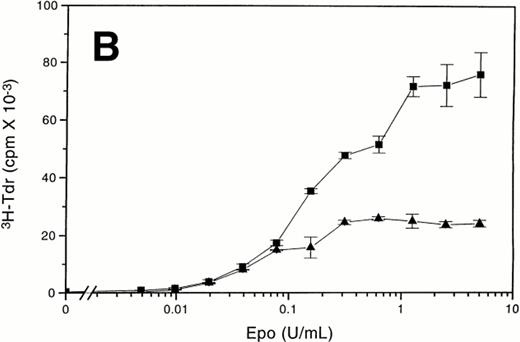

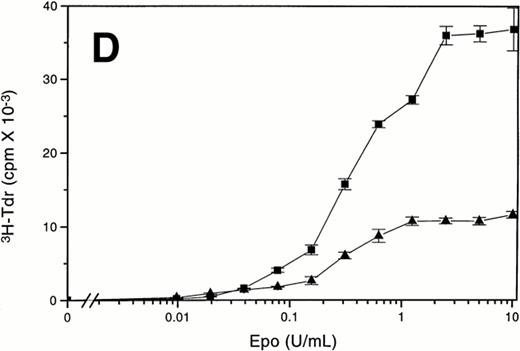
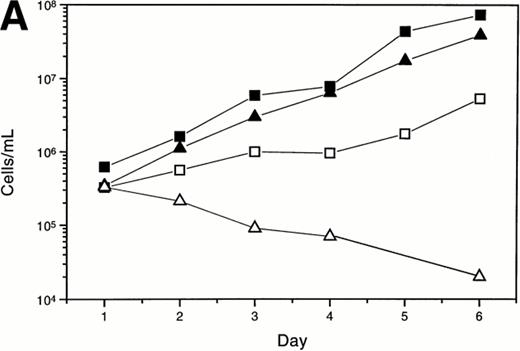
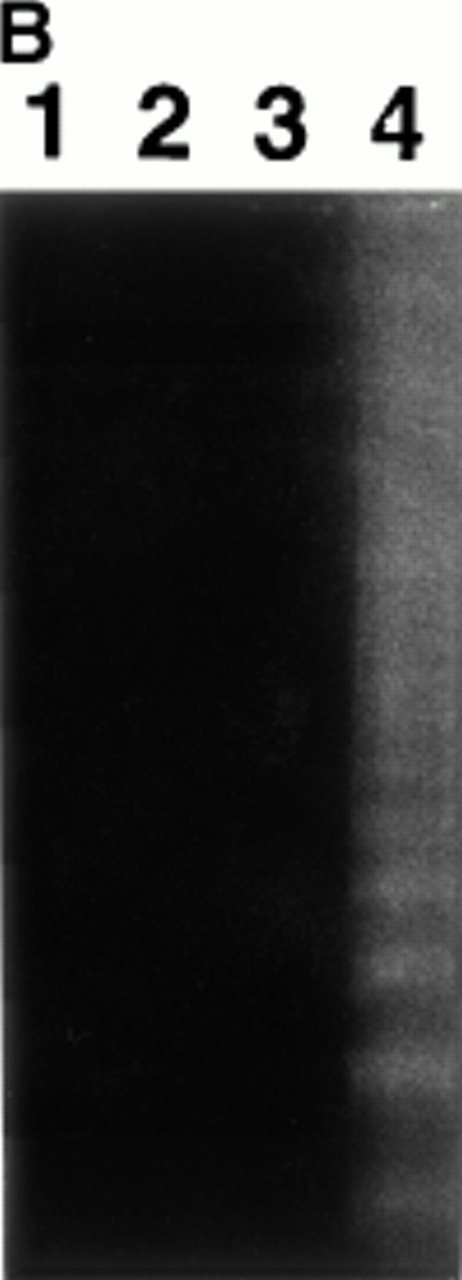
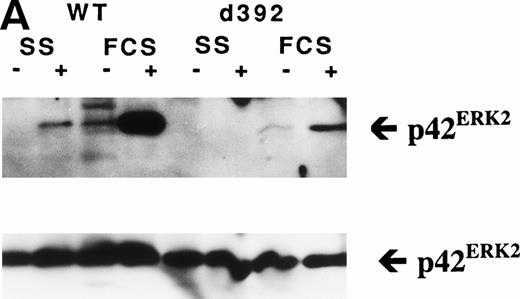
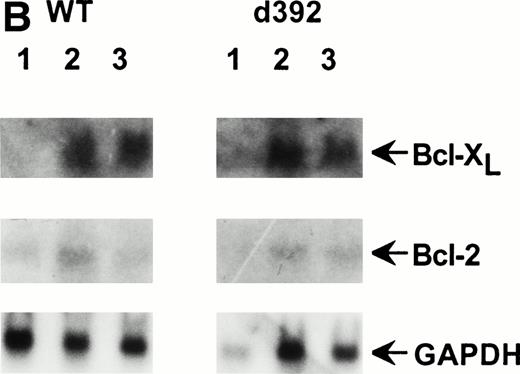
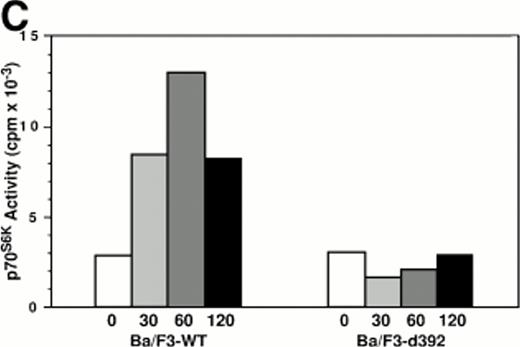
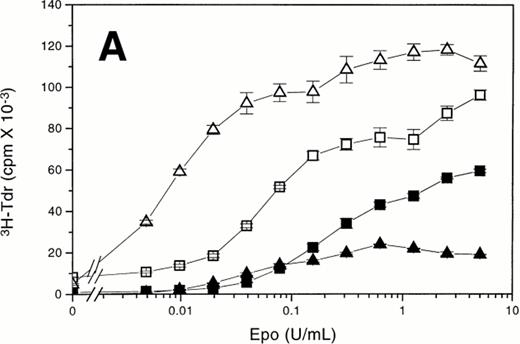
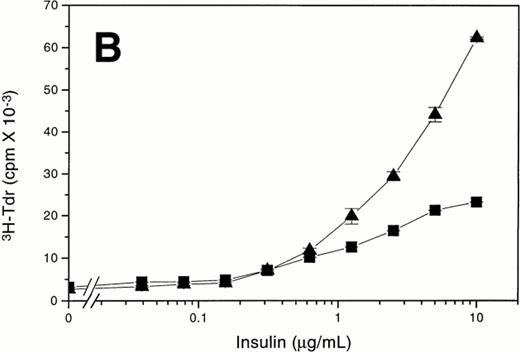



This feature is available to Subscribers Only
Sign In or Create an Account Close Modal